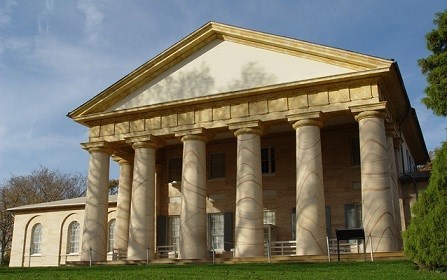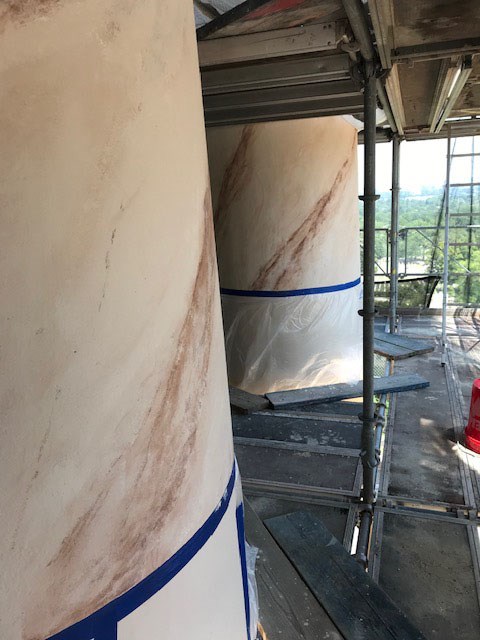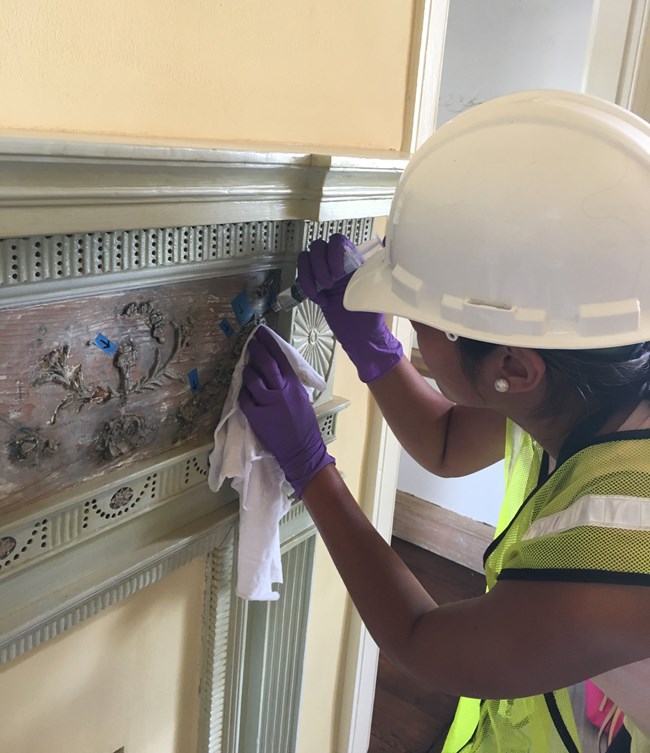Last updated: April 20, 2023
Article
Faux-painting and the Columns of Arlington House

NPS
From its hilltop perch by the Potomac River, the eight conspicuously colossal columns of Arlington House are visible to the capital city. Made of the same Aquia Creek sandstone that was used for the U.S. Capitol’s east portico columns and for other prominent buildings throughout the District, the 23 foot tall columns convey prominence, stature, and wealth. Or that was the idea anyway. Of course, they’re really colossal fakes.
The columns and the rest of the building’s façade are actually made of clay brick and mortar, plastered and painted to look like Aquia Creek sandstone. Huge hunks of stone for the columns and painstakingly tight fitted (ashlar) block for the facade. Instead of shipping quarried stones 40 miles north from Stafford County, VA, artisan laborers used a cost-saving painting technique called faux-painting to create the look of real stone. Today, Arlington House, and especially its columns, is one of the most prominent examples of this decorative technique in the United States.
Faux-painting was common in the mid-1850s as a way to save money but still convey the image of wealth. It was a time when society judged people by the types of stone and wood used in their homes. A stone house was better than a brick house which was, obviously, better than a wooden house.

Library of Congress
While Arlington House’s biggest example of faux-painting is on its exterior, most faux-painting was used indoors to embellish woodwork and create the look of high-grade woods like mahogany on doors, and fireplaces—the more expensive items of a home. This more common use of the technique can be seen at the Thomas House at Monocacy National Battlefield on the interior door and trim woodwork.
Today though, few skilled artisans can do faux-painting work. So now it’s cheaper to buy a mahogany door than to find someone who can paint mahogany onto a pine or oak door. Yet re-painting Arlington House’s iconic columns was on the work list when rehabilitation of the house began in 2018. The faux finishes were part of the rehabilitation work at Arlington House made possible by the generosity of philanthropist Mr. David Rubenstein who donated over $12 million to the National Park Foundation for the rehabilitation of Arlington House.
NPS staff* from the park, the regional historic architecture program, and the Historic Preservation Training Center all collaborated with the artisans doing the faux-painting work. The artisans created many draft designs using a color palette of beige, brown, orange, and reddish purple based on a 1995 paint analysis of the columns. And the shapes of layers and veins in the stone came from historic photos of Arlington House held by the Library of Congress. In the process, the team learned that it’s easy to go heavy-handed and do too much—some subtlety is required for a set of 8 huge columns. And that the original faux-painting artisan employed some artistic license in creating the look of the sandstone. The whole process was definitely a combination of art and science!

NPS
Today, the re-painting of the faux-painted columns is almost complete. And since they’re on the exterior of the house, you don’t have to wait to see them. As for the rest of the house, rehabilitation will wrap up in time for re-opening in January 2020.
*Park staff included Kimberly Robinson, Bradley Kruger, Matt Virta, and Simone Monteleone; regional historic architecture staff included Elizabeth Milnarik and Jacquelyn (Lindy) Gulick; and Historic Preservation Training Center staff included Todd Ravesloot and Fritz Rushlow.

NPS/Lindy Gulick
Beyond the columns
Another faux-painting related project at Arlington House was the stabilization of one of the house’s interior mantelpieces. The wooden mantel had likely once been garishly painted in a green and purple marble. Unfortunately, so little original paint remained that it was impossible to know exactly what the original colors and patterning would have looked like. As a result, it was not re-painted.
However, the set of small decorative ornaments along the top of the mantel did get some repair. A number of the small composition ornaments, called “compo” and made of composite resin similar to those used on gilded picture frames, were broken or loose. Regional historic architecture staff re-adhered and stabilized the compo using special injectable resin to prevent further damage.
